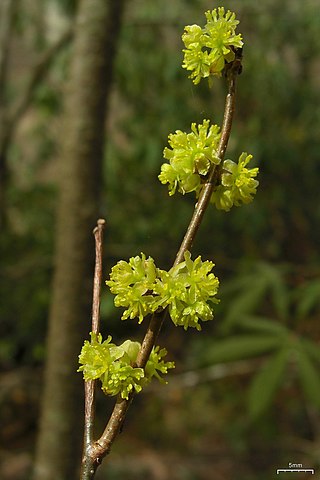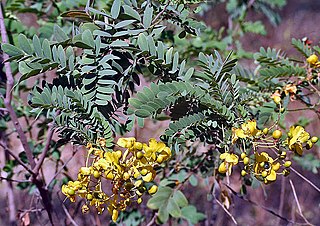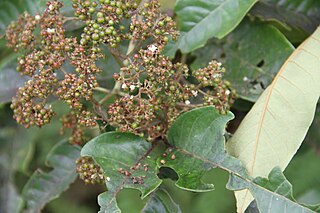
Robinia pseudoacacia, commonly known in its native territory as black locust, is a medium-sized hardwood deciduous tree, belonging to the tribe Robinieae of the legume family Fabaceae. It is endemic to a few small areas of the United States, but it has been widely planted and naturalized elsewhere in temperate North America, Europe, Southern Africa and Asia and is considered an invasive species in some areas. Another common name is false acacia, a literal translation of the specific name.

Cassia fistula, commonly known as golden shower, purging cassia, Indian laburnum, or pudding-pipe tree, is a flowering plant in the family Fabaceae. The species is native to the Indian subcontinent and adjacent regions of Southeast Asia, from southern Pakistan through India and Sri Lanka to Bangladesh, Myanmar and Thailand. It is a popular ornamental plant and is also used in herbal medicine.

Parkinsonia aculeata is a species of perennial flowering tree in the pea family, Fabaceae. Common names include palo verde, Mexican palo verde, Parkinsonia, Jerusalem thorn, jelly bean tree, palo de rayo, and retama.

Senna spectabilis is a plant species of the legume family (Fabaceae) in the subfamily Caesalpinioideae native to South and Central America. They are often grown as an ornamental in front yards, parks, gardens, buildings etc. due to their bright yellow flowers that bloom during the summer months. They are also known as golden wonder tree, American cassia, popcorn tree, Cassia excelsa, golden shower tree or Archibald's cassia.

Lindera benzoin is a shrub in the laurel family, native to eastern North America, ranging from Maine and New York to Ontario in the north, and to Kansas, Texas, and northern Florida in the center and south. Within its native range it is a relatively common plant where it grows in the understory in moist, rich woods, especially those with exposed limestone.
Androstachys johnsonii, the Lebombo ironwood, is a medium-sized Afrotropical tree species, and the sole member of the genus Androstachys in the Picrodendraceae. It is slow-growing, evergreen to deciduous, and dioecious, with flowers that are wind-pollinated. It is native to southeastern Africa and Madagascar, where it generally occurs gregariously on rocky hillsides, particularly in hot and dry situations. It produces a hard, durable wood which is of economic interest. Its specific name commemorates W. H. Johnson, a 19th-century Director of Agriculture in Mozambique. Four related species which are native to Madagascar, are usually placed in genus Stachyandra.

Vachellia karroo, commonly known as the sweet thorn, common acacia, Karoo thorn, Cape gum or cockspur thorn, is a species of Vachellia, in the Mimosa sub-family (Mimosoideae) of the Fabaceae or pea family, which is native to southern Africa from southern Angola east to Mozambique, and south to South Africa.

Ceratopetalum gummiferum, the New South Wales Christmas bush, is a tall shrub or small tree popular in cultivation due to its sepals that turn bright red-pink at around Christmas time. The petals are actually small and white - it is the sepals that enlarge to about 12mm after the flower sets fruit and starts to dry out.

Senna auriculata is a leguminous tree in the subfamily Caesalpinioideae. It is commonly known by its local names matura tea tree, avaram or ranawara, or the English version avaram senna. It is the State flower of Indian state of Telangana. It occurs in the dry regions of India and Sri Lanka. It is common along the sea coast and the dry zone in Sri Lanka.

Dichrostachys cinerea, known as sicklebush, Bell mimosa, Chinese lantern tree or Kalahari Christmas tree, is a legume of the genus Dichrostachys in the family Fabaceae.

Ochna serrulata is an ornamental garden plant in the family Ochnaceae which is indigenous to South Africa. It is planted in southern African gardens and is an invasive species in Australia and New Zealand.

Pultenaea gunnii, commonly known as golden bush-pea, is a species of flowering plant in the family Fabaceae and is endemic to south-eastern Australia. It is a slender, erect to spreading shrub with hairy young stems, egg-shaped to lance-shaped leaves with lance-shaped stipules at the base, and bright yellow and dark red flowers.

Harungana madagascariensis is a flowering plant found in Madagascar that is commonly known as the dragon's blood tree, orange-milk tree or haronga.

Senna italica, the Port Royal senna, Italian senna, or Senegal senna is a legume tree in the genus Senna. It is recognized by many other common names based on the regions it grows in. In India, it is used to produce a powder for treating hair-related diseases which is known as “neutral henna”. Whereas, in some parts of the world, this species is cultivated for the leaves which yield the drug senna, known commonly as Senna glycoside, which in turn is the base for a laxative. Senegal senna is easily distinguishable through its many distinctive features. There are 3 subspecies of this plant based on the size of the inflorescence and the length of the petiole. The subspecies are italica, micrantha, and arachoides. In many regions, this plant is cultivated commercially and medicinally.

Berberis canadensis, commonly known as the American barberry or Allegheny barberry, is a member of the family Berberidaceae. Berberis canadensis is one of only two simple-leaved or 'true' Berberis indigenous to the United States. The other is B. fendleri of the southwest U.S. The epithet "canadensis" literally means "Canadian" but was often used by 18th-Century botanists to refer to any plants growing in northeastern North America.

Sesbania punicea is an ornamental shrub with reddish-orange flowers. It has deciduous leaves and grows to a height of 15 feet. This plant has a high demand for water, and thrives in swamps or wet areas. It requires a mildly acidic soil, with a pH between 6.1 and 6.5.
Balanites angolensis, or Angolan green-thorn, is a species of tree from southern Africa, it is a member of the caltrop family, Zygophyllaceae.

Senna pendula, also known as Easter Cassia, Christmas Senna, winter Senna, climbing Cassia, golden shower, pendant Senna and valamuerto, is a plant of the Fabaceae family with a shrub habit that is native to South America. It used in various parts of the world as an ornamental plant and is an environmental weed in Australia. The flowers are yellow and the name pendula means 'pendulous' or 'drooping'.

Pultenaea dargilensis is a species of flowering plant in the family Fabaceae and is endemic to a small area in central Victoria, Australia. It is a leaning or low-lying shrub with narrow elliptic to lance-shaped leaves and yellow flowers usually arranged singly on the ends of branchlets.
Pultenaea insularis is a species of flowering plant in the family Fabaceae and is endemic to Kangaroo Island in South Australia. It is a spreading to prostrate shrub with wiry branches, elliptic leaves, and yellow and red flowers.

















